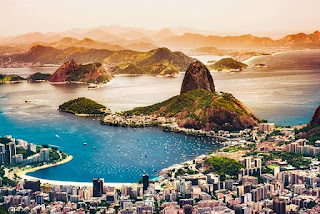Examining Brasília: The Contemporary Capital of Brazil
Tucked down in the centre of Brazil, Brasília is a monument to ambition, modernity, and inventiveness. This capital city, which was planned and constructed in just 41 months, is a marvel of urban design and architecture and represents Brazil's goals for advancement.
A Synopsis of the Past
The history of Brasília started in the late 1950s when then-President Juscelino Kubitschek initiated an ambitious plan to construct a new capital that would serve as a hub for economic expansion in Brazil's interior and a political power centre. Oscar Niemeyer, a well-known Brazilian architect, and Lúcio Costa, an urban planner, were brought in to design the city; Niemeyer produced the unique modernist structures, while Costa came up with the idea to organise the town in the form of an aeroplane.
Architectural Wonders
Brasília's avant-garde architecture, with its sweeping curves, bold lines, and futuristic forms, is one of its most remarkable aspects. Oscar Niemeyer built many of the architectural treasures found around the city. The National Congress is a well-known representation of Brazilian democracy, with its two towers and dome-shaped building. The Cathedral of Brasília is a captivating blend of modernism and devotion, with its hyperbolic shape and stained glass windows. Notable instances of Niemeyer's architectural prowess are the Palácio da Alvorada, the President's official residence, and the Palácio do Planalto, the Brazilian government's headquarters.
City Planning
Brazil's urban design is just as avant-garde as its architectural design. The city is divided into discrete sectors by Lúcio Costa's design, each with assigned uses such as residential, commercial, and governmental districts. The Monumental Axis, which contains the government buildings and cultural institutions, and the Residential Axis, which is home to the majority of the inhabitants, are the two crossing axes around which the city is arranged. Throughout the city, accessibility and simple navigation are guaranteed by this well-thought-out layout.
Cultural Centre
Apart from its political importance, Brasília is a thriving cultural centre featuring a diverse range of art, music, and food. The city is home to a large number of theatres, galleries, and museums exhibiting Brazilian culture—both traditional and modern. The National Library, National Museum of the Republic, and Cláudio Santoro National Theatre are housed in the Cultural Complex of the Republic, which is situated along the Monumental Axis and provides guests with a wide variety of cultural activities. Furthermore, restaurants in Brasília serve up inventive cuisine in addition to traditional fare, showcasing a blend of flavours from across Brazil.
Verdant Areas
Brasília is endowed with an abundance of green places and natural beauty, even with its metropolitan landscape. There are many of parks, gardens, and lakes throughout the city, offering chances for leisure and relaxation to both locals and tourists. One of the biggest urban parks in Latin America, Parque da Cidade Sarah Kubitschek, has picnic spaces, jogging paths, and breathtaking views of the city skyline. The Paranoá Lake is a well-liked location for recreational activities and water sports, while the Brasília Botanical Garden highlights the vast variety of the Brazilian cerrado habitat.
Gazing Forward
Brasília is still a representation of Brazil's aspirations and possibilities as it develops and grows. The capital city epitomises modernism and progress with its inventive architecture, well-thought-out urban design, and thriving cultural environment. Explore Brasília's architectural wonders, immerse yourself in its cultural activities, or just take in its green areas; anyway, visitors are invited to feel the vibrant vitality of Brazil's capital. Brasília is a monument to the strength of vision, imagination, and willpower as the country progresses into the future.





Comments